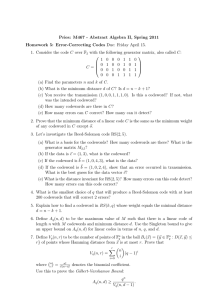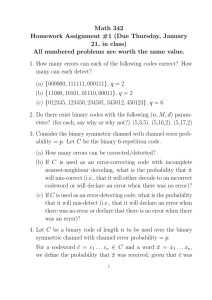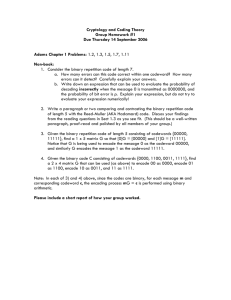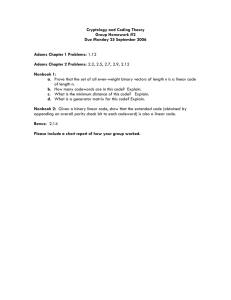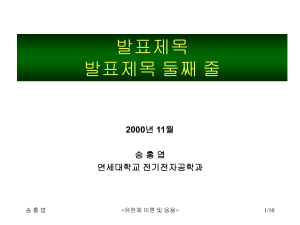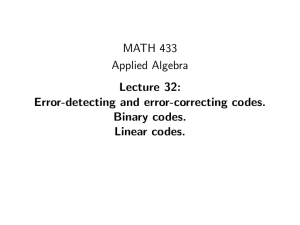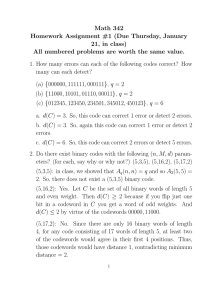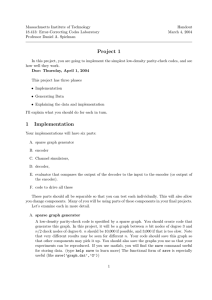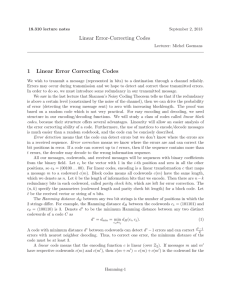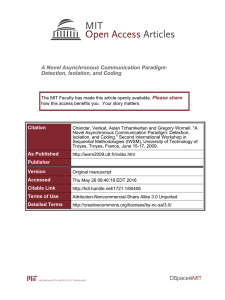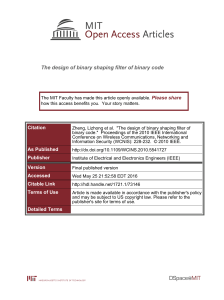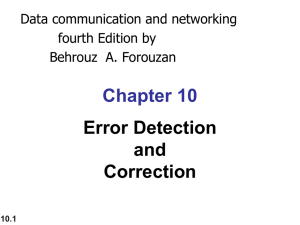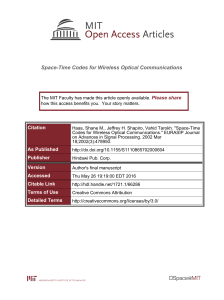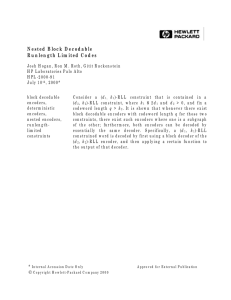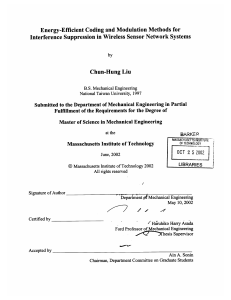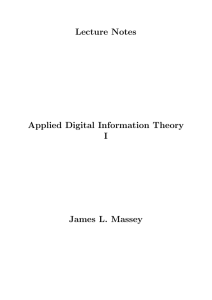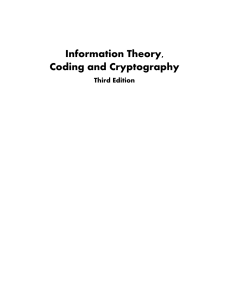Lecture 1: Math 342: Algebra and Coding Theory
advertisement
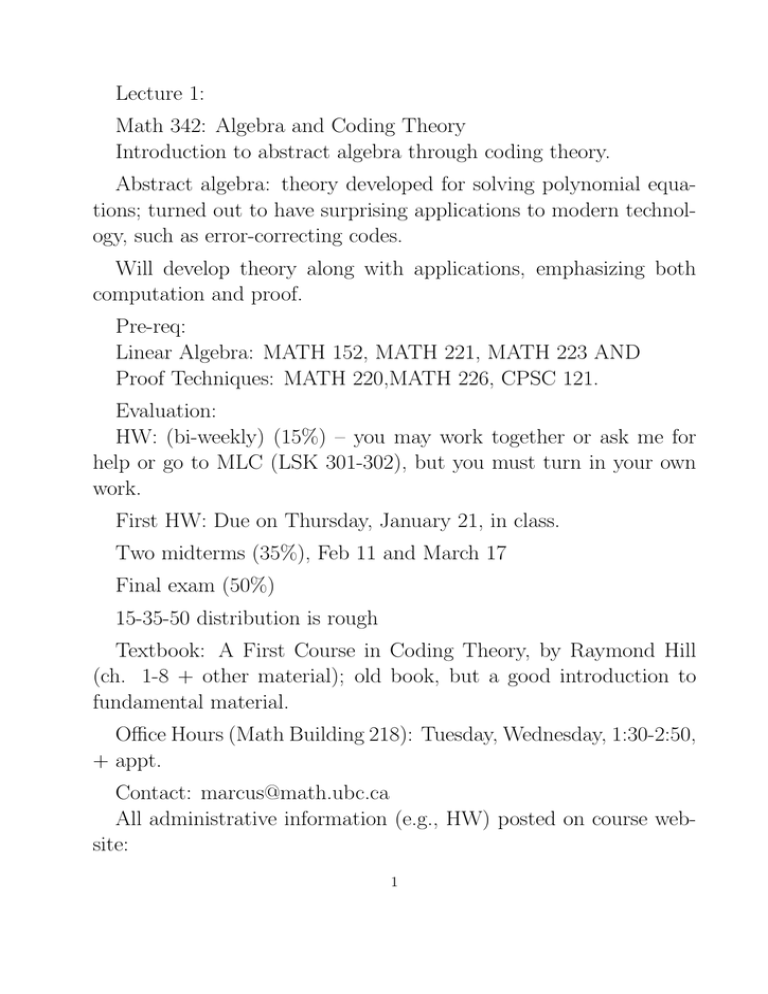
Lecture 1:
Math 342: Algebra and Coding Theory
Introduction to abstract algebra through coding theory.
Abstract algebra: theory developed for solving polynomial equations; turned out to have surprising applications to modern technology, such as error-correcting codes.
Will develop theory along with applications, emphasizing both
computation and proof.
Pre-req:
Linear Algebra: MATH 152, MATH 221, MATH 223 AND
Proof Techniques: MATH 220,MATH 226, CPSC 121.
Evaluation:
HW: (bi-weekly) (15%) – you may work together or ask me for
help or go to MLC (LSK 301-302), but you must turn in your own
work.
First HW: Due on Thursday, January 21, in class.
Two midterms (35%), Feb 11 and March 17
Final exam (50%)
15-35-50 distribution is rough
Textbook: A First Course in Coding Theory, by Raymond Hill
(ch. 1-8 + other material); old book, but a good introduction to
fundamental material.
Office Hours (Math Building 218): Tuesday, Wednesday, 1:30-2:50,
+ appt.
Contact: marcus@math.ubc.ca
All administrative information (e.g., HW) posted on course website:
1
http://www.math.ubc.ca/∼marcus/Math342
(or link through undergraduate tab of Math Dept website or my
personal website)
Today:
– Motivation for coding theory and simple examples
– Not-for-marks test: proof skills, from 10:15 - 10:45; just to get
an idea of your proof skills; do NOT put your name on your paper;
may have another test at the end of the term to assess improvement.
For this course,
CODING THEORY = ERROR-CORRECTION CODING
– But will briefly describe other kinds of coding: cryptographic
codes, data compression codes
Basic framework: communication over a noisy channel:
SENDER −→ NOISY CHANNEL −→ RECEIVER
Message −→ Received Message
Information to be transmitted can be data, images, voice
EXAMPLES of Noisy Channels:
– Communications (from here to there):
Telephone, Cell Phone, TV, Radio, Satelitte Communication (orbital and deep space), Internet communication
– Recording or Storage (from now to then):
Hard disk drives for computers, Flashstick, CD, DVD, IPOD, Digital Cameras
Bar codes for product identification (read by scanners)
Errors are inevitable! Sources of noise:
2
– Electronics noise, mechanical imperfections,atmospheric disturbances, signal power loss over large distances, interference from structures or cosmic rays, . . .
– Humans pushing technology to limits
Simple Mathematical Channel Model: Binary Symmetric Channel (BSC) and diagram:
—- binary inputs 0,1
—- binary outputs 0,1
—- a “channel error” means that an input bit is flipped (because
of noise), i.e., a transmitted 0 is received as a 1 or a transmitted 1 is
received as a 0.
—- error (i.e., flipped bit) with channel error probability or crossover
probability p: think of p as small, say p ≈ 10−4.
Q: How to detect or correct errors?
A: Add redundancy in order to detect or correct (a limited number
of) errors.
SENDER −→ ENCODER(1-1 mapping) −→ NOISY CHANNEL
−→ DECODER (not 1-1) −→ RECEIVER
WORD −→ CODEWORD −→
RECEIVED WORD −→ DECODED MESSAGE
Example: 2-repetition code
– Encoder (1-1 mapping):
Message −→ codeword
——————————————
0 −→ 00
3
1 −→ 11
– Decoder (NOT a 1-1 mapping):
00 −→ 0
11 −→ 1
01 or 10: Declare an error and request re-transmission.
Performance, within each 2-bit codeword:
– If neither bit is in error, then transmission is fine.
– If only one of the two bits is in error, then error is detected.
– If both bits are in error, then the decoder mis-corrects.
We say that the code is 1-error-detecting.
Trade-off: Message Transmission rate is cut in half: it takes two
coded bits to represent one message bit. No free lunch!!
Other problems with error detection:
– Need a reliable “return channel” to request re-transmission
– Sometimes transmitted information is gone immediately after
transmission
– Re-transmission causes delay in reception of information
It would be much better if we can actually correct errors rather
than merely detect errors, in a manner that it transparent to the
receiver. We can!
– Example: 3-repetition code:
Encoder:
Message −→ codeword
——————————————
0 −→ 000
4
1 −→ 111
Decoder (Majority vote):
000 or 100 or 010 or 001 −→ 0
111 or 011 or 101 or 110 −→ 1
Performance within each 3-bit codeword:
– If no errors are made, transmission is fine.
– If only 1 error is made, then error is corrected.
– If 2 or 3 errors are made, then the decoder will mis-correct.
We say that the code is 1-error-correcting.
In contrast, the 2-repetition code cannot correct any errors.
Hamming story: from error-detection to error-correction.
Trade-off: Message Transmission rate is cut by a factor of three:
it takes three coded bits to represent one message bit.
5
Lecture 2:
To discuss your skills test paper, contact Sandi Merchant merchant@math.ubc.ca
Recall 3-repetition code, which can correct any single error in each
3-bit codeword.
Transmit a string of information by several repeated uses of the
3-repetition code:
message:
0 1 0 0 1 1 0
transmitted codewords: 000 111 000 000 111 111 000
received words:
010 111 110 000 101 001 001
decoded message:
0 1 1 0 1 0 0
In some situations, you can cope with a small number of message
errors (e.g., images). In other situations, you need to use a more
powerful error-correcting code or a cascade of more than one code.
Is the tradeoff between error correction and message transmission
rate worthwhile?
Coded error probability:
– Recall BSC with channel error probability p: diagram
– Assume channel errors are made independently, from time slot
to time slot.
– For 3-repetition code, a decoding error is made if 2 or 3 channel
errors are made (within a 3-bit block). So, the coded error probability is
pc := 3p2(1 − p) + p3 = 3p2 − 2p3 << p, if p is small; e.g., for
p = 10−4, then is 3 ∗ 10−8 − 2 ∗ 10−12 < 10−7.
Reduction in error probability by several orders of magnitude at
the cost of slowing the message transmission rate by a factor of 3.
6
Alternatively, we can often use an error-correcting code to actually
increase the message transmission rate without increasing the error
probability.
– Say that channel operates at R channel bits per second, with
channel error probability p = p(R)
– With the 3-repetition code, it operates at R/3 message bits per
second, with decoded error probability pc(R) << p(R)
– Increase the channel transmission rate from R to kR where k is
maximized subject to pc(kR) ≤ p(R).
– Then, with the 3-repetition code, we get kR/3 message bits per
second with decoded error probability ≤ p(R).
– If k > 3, we win: coding gives a higher message information
rate, than without coding.
– Whether k > 3, depends on the nature of the function p(R),
which depends on the details of the physical channel.
Decoder tries to recover the message word in two steps:
(i) given received word, finds the most likely transmitted codeword
(difficult part)
(ii) inverts the encoder (easy part)
Note: sometimes “decoder” means a function that does only step
1.
Imagine the space of all received words, and balls around each
codeword c representing the most likely possible received words. In
order to correct errors, the balls should be disjoint or nearly disjoint.
Objective 1: Thus, we want well-separated codewords.
7
Objective 2: On the other hand, we want to transmit lots of distinct messages by distinct codewords and so there should be lots of
codewords.
These are the two main objectives of a “good” code.
There is a fight between the objectives.
Notation: for a finite set S, |S| denotes the number of elements in
S.
Formal Defns:
Code alphabet (symbols): any set finite set, written Fq = {a1, a2, . . . , aq }.
Usually, Fq = Zq = {0, 1, . . . , q − 1}
– so q = |Fq |
– main example: F2 = Z2 = {0, 1}, q = 2 (the binary case)
q-ary word of length n over Fq : a sequence (string) x = x1x2 . . . xn,
where each xi ∈ Fq .
q-ary block code (or code) : a nonempty set C of q-ary words all
of the same length n.
– q = 2: binary code
codeword: an element of a code C
A CODE IS A SET OF WORDS, CALLED CODEWORDS.
length of a code: n, the (common) length of the codewords in C.
size of a code C, denoted M = |C|: the number of codewords in
C
(n, M )-code: length n and size M
Examples: q = 2:
2-repetition code (n, M ) = (2, 2)
{aa, bb} (n, M ) = (2, 2)
8
3-repetition code (n, M ) = (3, 2)
n-repetition code (n, M ) = (n, 2)
C1 = {00, 01, 10, 11}, (n, M ) = (2, 4)
C2 = {000, 011, 101, 110} (n, M ) = (3, 4)
C3 = {00000, 01101, 10110, 11011}(n, M ) = (5, 4)
q = 3 (ternary):
C4 = {000000, 111111, 222222} (n, M ) = (6, 3)
Note: in this class, we will not consider variable length codes
We need a way to measure distance between words of the same
length.
Defn Hamming distance: for words x = x1 . . . xn, y = y1 . . . yn
of the same length,
d(x, y) = |{1 ≤ i ≤ n : xi 6= yi}|
i.e., d(x, y) is the number of of places at which x and y differ.
– Example: d(01101, 10011) = 4, d(12345, 14134) = 4;
– Note: magnitude of difference is irrelevant.
Properties of Hamming distance:
Proposition: d(x, y) is a metric, i,e.,
(0) d(x, y) ≥ 0
(1) d(x, y) = 0 iff x = y
(2) d(x, y) = d(y, x)
(3) d(x, z) ≤ d(x, y) + d(y, z) (triangle inequality)
Proof: 0, 1 and 2 are obvious.
Next lecture: proof of 3.
9

